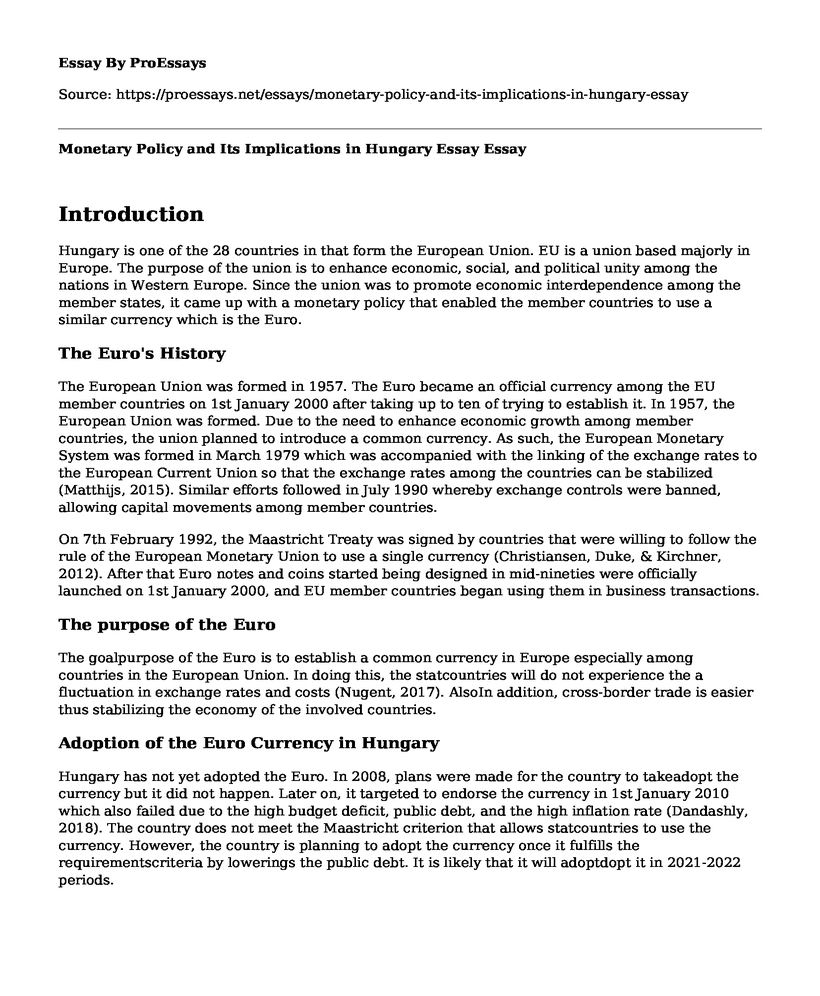Introduction
Hungary is one of the 28 countries in that form the European Union. EU is a union based majorly in Europe. The purpose of the union is to enhance economic, social, and political unity among the nations in Western Europe. Since the union was to promote economic interdependence among the member states, it came up with a monetary policy that enabled the member countries to use a similar currency which is the Euro.
The Euro's History
The European Union was formed in 1957. The Euro became an official currency among the EU member countries on 1st January 2000 after taking up to ten of trying to establish it. In 1957, the European Union was formed. Due to the need to enhance economic growth among member countries, the union planned to introduce a common currency. As such, the European Monetary System was formed in March 1979 which was accompanied with the linking of the exchange rates to the European Current Union so that the exchange rates among the countries can be stabilized (Matthijs, 2015). Similar efforts followed in July 1990 whereby exchange controls were banned, allowing capital movements among member countries.
On 7th February 1992, the Maastricht Treaty was signed by countries that were willing to follow the rule of the European Monetary Union to use a single currency (Christiansen, Duke, & Kirchner, 2012). After that Euro notes and coins started being designed in mid-nineties were officially launched on 1st January 2000, and EU member countries began using them in business transactions.
The purpose of the Euro
The goalpurpose of the Euro is to establish a common currency in Europe especially among countries in the European Union. In doing this, the statcountries will do not experience the a fluctuation in exchange rates and costs (Nugent, 2017). AlsoIn addition, cross-border trade is easier thus stabilizing the economy of the involved countries.
Adoption of the Euro Currency in Hungary
Hungary has not yet adopted the Euro. In 2008, plans were made for the country to takeadopt the currency but it did not happen. Later on, it targeted to endorse the currency in 1st January 2010 which also failed due to the high budget deficit, public debt, and the high inflation rate (Dandashly, 2018). The country does not meet the Maastricht criterion that allows statcountries to use the currency. However, the country is planning to adopt the currency once it fulfills the requirementscriteria by lowerings the public debt. It is likely that it will adoptdopt it in 2021-2022 periods.
Fluctuations of the Euro against the Value of the US Dollar
There have been fluctuations in the exchange rate between the Euro and the US Dollar since the introduction of the currency. Some of the causes of the changefluctuations included the shifting minds of investors from the Euro to the US dollar and vice versa. The recent volatilityfluctuations occurred between January and March 2018. On 1st January, the Euro cost 1.20 US dollars which rose to 1.124 US dollars on 27th March (Morana, 2017). Based on these changes, the European tends to be growing stronger against the US economy.
Challenges Facing Common Currency in the European Union
Although the idea of communizing the Euro among EU member countries seemed fitting for business growth, it has been accompanied by other challenges which are pulling back its benefits. Firstly, coordinating monetary policies among member countries has been a difficulty since member states have differentvarying aspirations. For example, Germany wishes to keep its interest rates high due to its massive economy while Greece hopwishes the interest rate to go low so that it can boost its economy slows (Stiglitz, 2016). Thus, the union finds it had to coordinate such countries with monetary differences. Another challenge is that some countries in the union such as Greece need have always demanded some financial assistance from the union. Such debts can affect the stability of EU and hence result in some disagreements among member countries. As such, the use of common currency tends to influenceaffect other countries nations in the union that hass set goals towards development and not standing to save member countries with financial instability.
References
Christiansen, T., Duke, S., & Kirchner, E. (2012). Understanding and assessing the Maastricht Treaty. Journal of European Integration, 34(7), 685-698.
Dandashly, A., & Verdun, A. (2018). Euro adoption in the Czech Republic, Hungary, and Poland: Laggards by default and laggards by choice. Comparative European Politics, 16(3), 385-412.
Matthijs, M., & Blyth, M. (Eds.). (2015). The future of the Euro. Oxford University Press, USA.
Morana, C. (2017). The US Dollar/Euro Exchange Rate: Structural Modeling and Forecasting During the Recent Financial Crises. Journal of Forecasting, 36(8), 919-935.
Nugent, N. (2017). The government and politics of the European Union. Palgrave.
Stiglitz, J. E. (2016). The euro: How a common currency threatens the future of Europe. WW Norton & Company.
Cite this page
Monetary Policy and Its Implications in Hungary Essay. (2022, Oct 06). Retrieved from https://proessays.net/essays/monetary-policy-and-its-implications-in-hungary-essay
If you are the original author of this essay and no longer wish to have it published on the ProEssays website, please click below to request its removal:
- Paper Example on Managing Liquidity Risk in the Banking Industry
- Bitcoin and Its Controversies Essay
- How Would You Reform the UK Tax System if You Wished to Increase the Level of Economic Efficiency?
- Globalization in Financial Market: A Review of Research and Theories - Essay Sample
- Crisis Comm: Traditional Models, Social Media, & Current Challenges - Essay Sample
- How Spark NZ Limited Can Strategically Adapt to Dynamic Telecommunication Industry - Essay Sample
- Free Report Sample on Zero-Based Budgeting: Optimizing Financial Health for Companies







